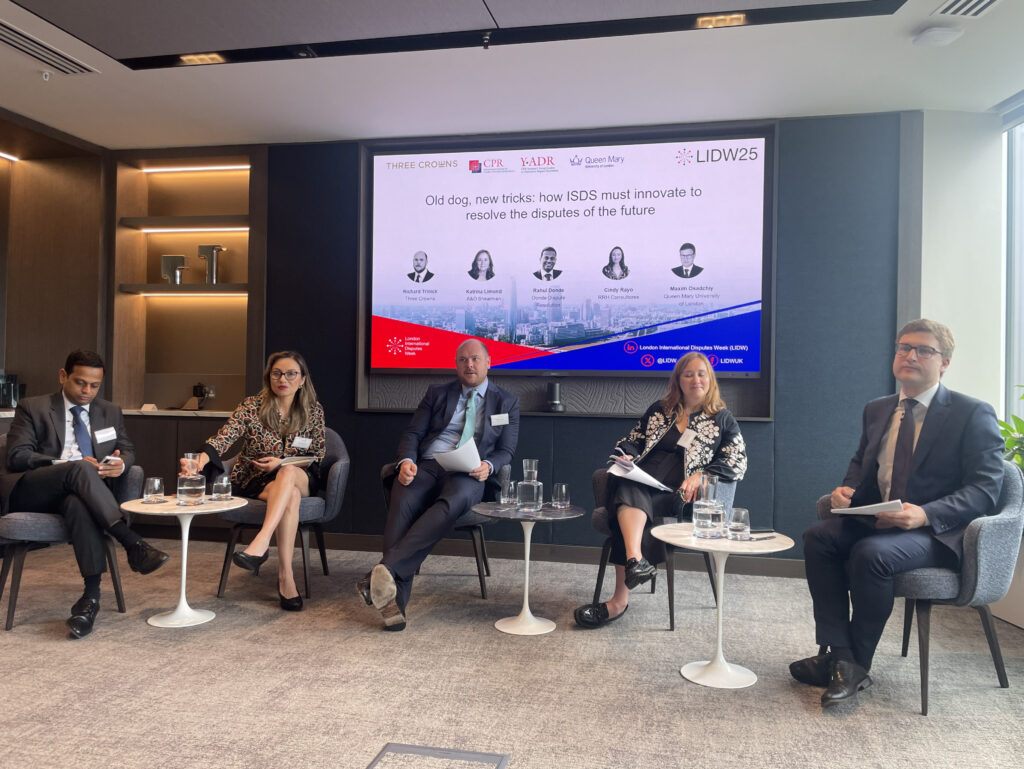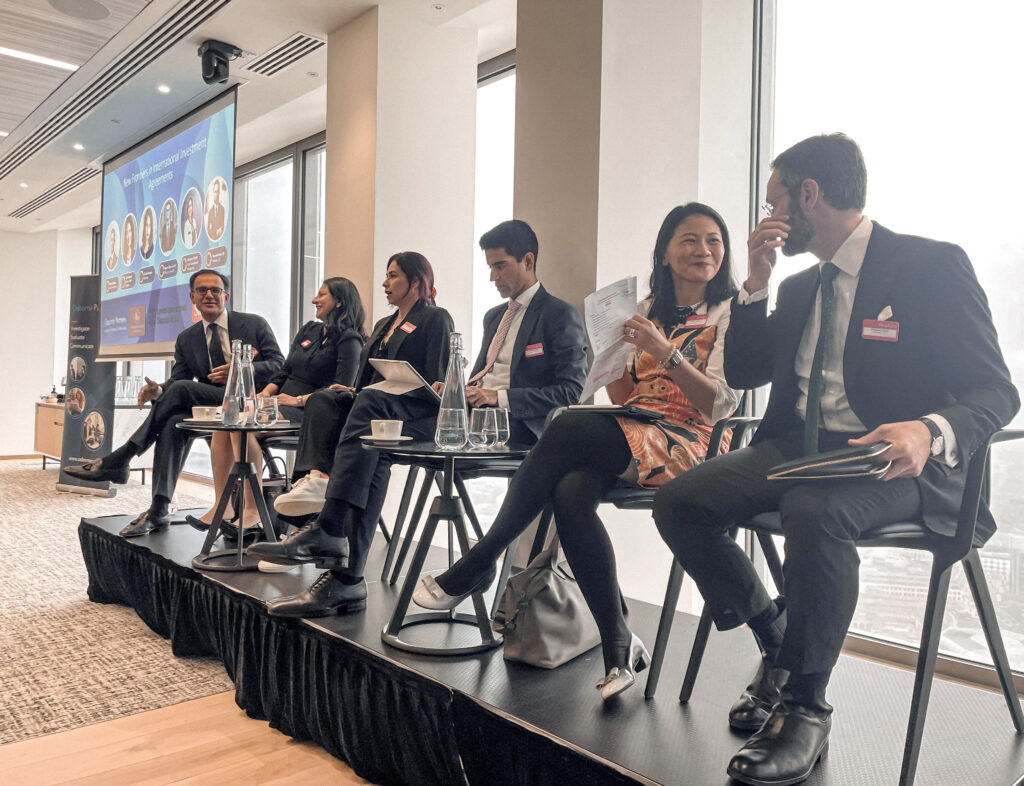The future of Investor-State Dispute Settlement (“ISDS”) was a key topic of discussion at several events during London International Disputes Week (“LIDW”). Two panels, in particular, explored how the ongoing legitimacy crisis in ISDS is being addressed through recent procedural and substantive reforms, and what these developments may signal for the system’s future.
Three Crowns hosted a panel discussion titled “Old Dog, New Tricks: How ISDS Must Innovate to Resolve the Disputes of the Future.” Moderated by Richard Trinick (Three Crowns), the panel included Katrina Limond (A&O Shearman), Maxim Osadchiy (Queen Mary University of London), Cindy Rayo Zapata (RRH Consultores) and Rahul Donde (Donde Dispute Resolution).
Following this, Skadden presented a session titled “New Frontiers in International Investment Agreements,” moderated by Shaneen Parikh (Cyril Amarchand Mangaldas) and Montek Mayal (Osborne Partners). The panel featured Hussein Haeri KC (Withers), Dipen Sabharwal KC (White & Case), Devika Khopkar (Skadden), and Gitta Satryani (Herbert Smith Freehills).
This post highlights the key insights and takeaways from these discussions, offering a snapshot of current trends and future directions in ISDS.
Current Trends in the ISDS Framework

Trend 1: Limiting the scope of investors protected
One identified trend—and one that panellists believe will become even more prominent in the future—is the limitation on investors protected under those treaties. The new United States-Mexico-Canada Agreement (“USMCA”), for example, provides that only investors in certain sectors can bring claims covering the full scope of protection. Other investors may still submit claims, but limited to by a narrower scope of protection. The Energy Charter Treaty (ECT) provides protection for investors in the energy sector. However, the modernized version of the treaty allows for a carve-out of certain investments made in the fossil fuel industry.
Trend 2: New Substantive Clauses
The panellists also discussed some of the main changes seen in traditional clauses of investment treaties to address some of the dissatisfactions with the ISDS system.
- New Fair and Equitable Treatment (“FET”) Clauses. The early generation of investment treaties had a simple FET clause, which led to a lot of controversy due to the broad interpretation given by tribunals to these clauses. As a result of this controversy, investment treaties have followed three different paths: (1) to remove the FET clause from the treaty, excluding any kind of protection under such a standard—a rare but existing approach; (2) to link the FET clause to customary international law; or (3) to create an FET clause that sets out a list of measures that would or would not qualify as FET. One example cited was the new Indonesia–Switzerland BIT (2022), which not only includes a list of measures that can constitute a breach of FET but also provides guidance on how to consider the legitimate expectations of investors.
- New Most Favoured Nation (“MFN”) Clauses. Another traditional clause that has been subject to much discussion regarding its application is the MFN clause, especially in relation to its application to dispute resolution clauses. As with FET clauses, there is an increasing tendency to clarify the situations in which the MFN clause applies or does not apply. The Comprehensive and Progressive Agreement for Trans-Pacific Partnerships (CPTPP) was cited as one example of this tendency—the treaty expressly excludes from the MFN clause international dispute resolution procedures or mechanisms such as those included in ISDS. There are also States that have decided to exclude MFN clauses from their treaties, as seen in the Brazil–India BIT (2020).
The application of the MFN clause is often viewed as so problematic that, even in treaties explicitly extending MFN treatment to dispute resolution provisions, its scope may still be limited by judicial or arbitral interpretation. A cited example was the annulment of the award in Zaza Okuashvili v Georgia by the Swedish High Court, in which the court ruled that the MFN clause could not allow parties to choose a dispute resolution forum different from the one specified in the BIT, despite the Georgia–UK BIT (1995) containing a specific provision that extended MFN treatment to dispute resolution mechanisms.
- New Expropriation Clauses. It was also discussed how expropriation clauses have evolved from their first “skinny” version to adopting more and more guidelines, both in terms of direct and indirect expropriation. Direct expropriation clauses have changed to incorporate the conditions for lawful expropriation and some guidelines regarding the economic model, or the dates considered in the calculation of due compensation. These guidelines, as observed by the panellists, should not impair the investor’s right to adequate and effective compensation, remembering that in ADC v Hungary, the tribunal rejected the treaty’s guidelines for not reflecting adequately the value of the investment.
Indirect expropriations are highly debated, especially due to their tension with a State’s right to regulate. One example discussed was Indonesia: after initially facing numerous investor claims and terminating its treaties, it re-entered treaty-making with a revised approach. Its newer treaties, like the Indonesia–Singapore BIT (2018), maintain a basic expropriation clause but include an annex outlining specific conditions for indirect expropriation. These conditions consider factors such as the degree of interference, investor expectations, economic impact, and proportionality. The annex also clarifies that non-discriminatory measures taken for legitimate public purposes do not qualify as indirect expropriation. Similar provisions appear in other treaties, such as the EU–Vietnam Investment Protection Agreement (2019).
Trend 3: Counterclaims and Investors’ Obligations
To restore balance in the ISDS system, discussions focused on empowering States not only to defend against claims but also to actively respond. Counterclaims were highlighted as a key tool, allowing States to raise their own concerns, which can enhance legitimacy and improve dispute resolution efficiency.
Panellists also noted efforts to include investor obligations in treaties, alongside their rights. This shift aims to create a more balanced system and streamline procedures. An example is the Chile–EU Advanced Framework Agreement (2023), which allows States to bring claims not only related to the investment but also concerning the investor’s failure to meet international obligations.
Trend 4: Exhaustion of Local Remedies
The requirement for the exhaustion of local remedies, which originates from customary international law, was cited as one of the possible trends in the future of ISDS. Involving national courts more directly in the ISDS framework was presented as a potential way to enhance the legitimacy of the dispute resolution process as a whole. The USMCA was again cited as an example, as it provides that certain investors are required to comply with the exhaustion of local remedies before gaining access to the ISDS system.
The Future of Disputes to Expect in ISDS

Both panels also engaged in an exercise to anticipate the types of disputes that may arise under the ISDS system in the future. Some of the disputes mentioned included:
- Outer Space Disputes: Both panels noted a likely increase in disputes related to outer space activities, based on three main factors. First, satellite technology is becoming more accessible due to increased competition. Second, more frequent satellite launches raise the risk of collisions and related damage claims. Third, the complex supply chains and licensing involved in satellite operations expand the potential for disputes.
- Climate Change and Energy Transition Disputes: The ongoing measures to address the climate crisis, including the global shift towards energy transition, were also identified as a continuing source of ISDS claims in the future.
- Digital Decentralised Assets: Disputes involving digital decentralised assets were mentioned as another area likely to see growth, due to the increasing presence of such assets in the global market.
- Transfer Provisions: Panellists also anticipated a rise in disputes related to the free transfer of funds, particularly in light of the impact that recent sanctions have had on foreign investors.
- Technology Disputes: Finally, disputes involving the use of new technologies—such as Artificial Intelligence—were highlighted. Panellists referred to existing arbitration frameworks developed to address such issues, including the Blockchain Expedited Arbitration Rules by the London Chamber of Arbitration and Mediation(LCAM), aimed at resolving disputes in the Web3 and digital asset space, and the UNCITRAL Model Clauses on Specialised Express Dispute Resolution (SPEDR), which were drafted with the focus on technology-related disputes.
Conclusion
Expectations for the future of ISDS remain closely linked to addressing past criticisms. While the system must continue protecting investors’ rights, it also needs to adapt to the evolving needs of States. Both panels suggested that the future lies in greater codification within investment treaties, offering States more regulatory space and limiting tribunals’ interpretive discretion. However, this shift will require tribunals to adapt to interpreting more detailed provisions. Codification alone will not resolve complex issues, such as how tribunals assess the legitimacy of public interest measures.
The discussions made clear that investment treaties have evolved significantly since the 1990s. Yet, challenges persist, and ongoing technological and geopolitical developments are likely to keep driving investment disputes in the foreseeable future.
This post is part of Kluwer Arbitration Blog’s coverage of London International Disputes Week 2025.
________________________
To make sure you do not miss out on regular updates from the Kluwer Arbitration Blog, please subscribe here. To submit a proposal for a blog post, please consult our Editorial Guidelines.


